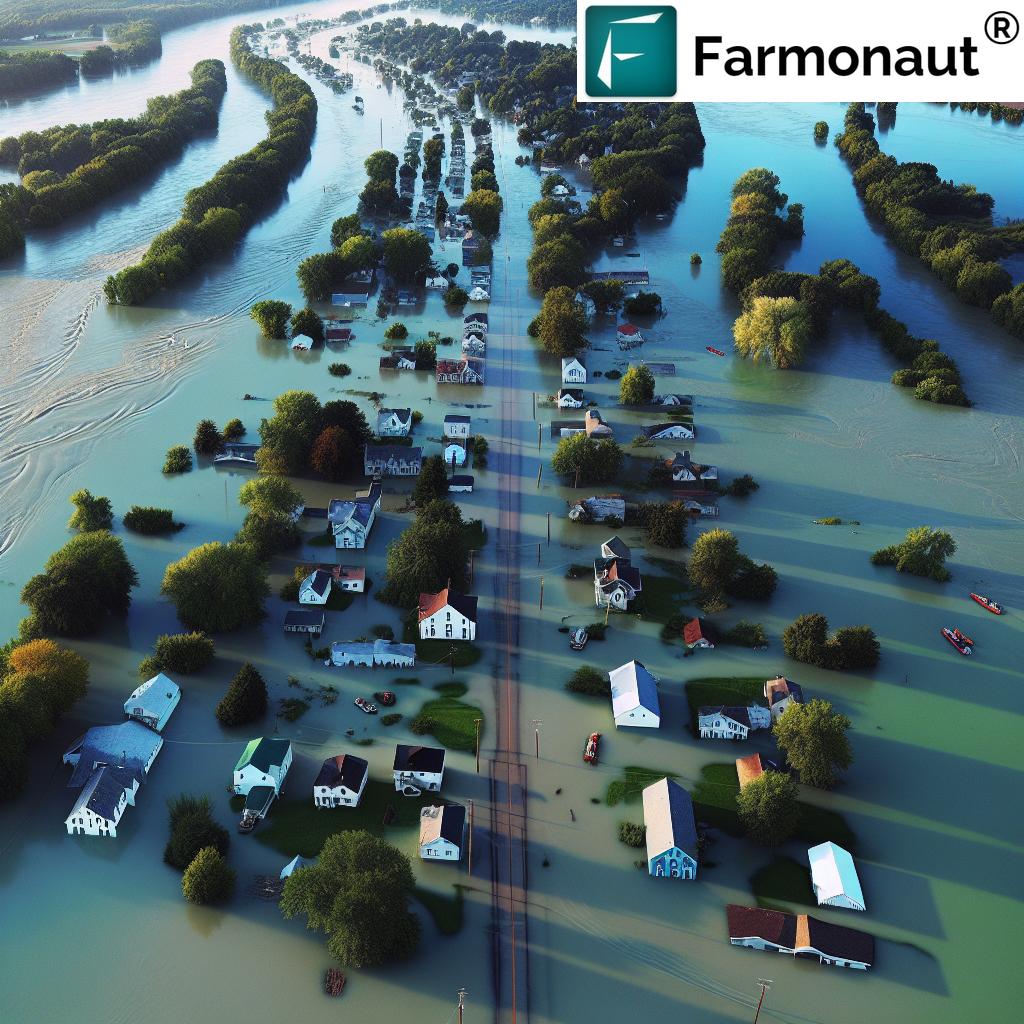Arkansas River Flood, Flooding 2025, Drought & Wildfire Map: Impacts, Risks, and Adaptive Solutions
In 2025, Arkansas faced a convergence of environmental crises: major flooding along the Arkansas River, persistent drought in western regions, and a rapidly increasing risk of wildfires. These natural events have placed stress on agriculture and forestry sectors, highlighting the urgent need for integrated, sustainable management solutions across the state. This comprehensive blog post explores the wide-ranging implications of the Arkansas River flood 2025, details on drought and wildfire threats from the Arkansas drought monitor and wildfire map, and discusses adaptive, resilient approaches for farming, forestry, and natural resource protection in the future.
“In 2025, Arkansas River flooding affected over 200,000 acres of farmland, highlighting urgent needs for adaptive agriculture.”
Arkansas River Flood 2025: A Detailed Overview
The Arkansas River flood 2025 stands as one of the most significant environmental challenges impacting the state in recent memory. Triggered by months of above-average precipitation in the upper river watershed, record-setting heavy rains in early spring led to the Arkansas River exceeding flood stage levels along wide stretches of its course.
The rapidly rising floodwaters inundated low-lying agricultural lands, particularly in the fertile Arkansas Delta. This region is a vital part of the state’s economy, traditionally producing rice, soybeans, and cotton. In 2025, the impact was acute:
- Planting schedules were disrupted, delaying or outright preventing crop establishment.
- Growing crops—including rice, soybeans, and cotton—suffered immense flood damage.
- Soil erosion and sediment deposition changed farmland topography and decreased future productivity.
As flooding extended into forested areas, especially in southeastern Arkansas, saturated soils destabilized root systems. This increased the risk of tree falls, complicating both timber harvesting and access to logging roads. For those working in forestry, the disruptions meant:
- Delays in & severe limitations to logging operations
- Damage to critical access roads needed for timber transporting
- Heightened vulnerability to future adverse effects from floods
This event underscored the need for improved floodplain management and the integration of natural buffers such as riparian wetlands and reforestation efforts across vulnerable lands.
Major Factors Behind Arkansas River Flooding in 2025
- Above-Average Precipitation: The river’s watershed experienced sustained storms, swelling tributaries and main river levels.
- Spring Melting: A rapid thaw of upstream snows led to increased runoff.
- Floodplain Encroachment: Ongoing development limited the natural capacity of the floodplain to disperse overflow floodwaters.
- Soil Saturation: Previous heavy rainfall saturated many soils, reducing absorption capacity and leading to quicker flooding.
Flooding’s Chain Reaction Across the Region
The Arkansas River flood 2025 set off a cascade of environmental and economic consequences including:
- Widespread soil erosion—displacing fertile soil and mixing sediment within riverbeds
- Deposition of silt and debris on previously productive lands
- Threats to water quality from agricultural runoff and contaminants
- Increased pest and weed pressure due to changed soil/land conditions and delays in management
- Disruption to community infrastructure, including roads, bridges, and agricultural centers
2025 Arkansas River Flood, Drought, and Wildfire Impact Summary Table
| Event Type | Estimated Area Affected (sq miles) | Estimated Impacted Population | Primary Environmental Impact | Counties/Regions Most Affected | Suggested Adaptive Solutions |
|---|---|---|---|---|---|
| Flood 2025 | 2,500 | 180,000 | Soil loss, crop destruction, water pollution | Arkansas Delta, Little Rock, Pine Bluff, Jefferson, Desha, Phillips |
Floodplain restoration, improved drainage, riparian buffers, resilient crop systems Forestry & Crop Advisory |
| Drought 2025 | 5,000 | 320,000 | Soil moisture loss, reduced crop yields, stress on livestock & water resources | Western Arkansas, Ozark Plateau, Polk, Scott, Logan counties |
Drought-resistant crops, water conservation, precision irrigation, soil management Soil Health & Carbon Tracking |
| Wildfire 2025 | 1,100 | 100,000 | Forest area burned, loss of biodiversity, threat to rural communities | Southeastern, Western, and Ozark National Forest regions |
Controlled burns, forest thinning, reforestation, fire monitoring systems Fleet & Resource Monitoring |
Flooding Impacts on Arkansas Agriculture and Forestry: Risks & Realities
Flooding in 2025 has dramatically underscored the vulnerabilities of Arkansas’s agriculture and forestry sectors. Specific ramifications include:
Flooding’s Direct Impact on Agricultural Land & Production
- Loss of arable land: More than 200,000 acres (according to reports) were inundated, many for weeks.
- Reduction in planting windows: Farmers, especially in the Arkansas Delta, scrambled to adapt planting schedules and re-evaluate crop choices.
- Soil degradation: Heavy flooding caused erosion and sediment build-up, hindering crop growth and reducing soil fertility for future seasons.
- Infrastructure damage: Outbuildings, equipment storage, and rural roads suffered, which complicated not only this year’s harvests but also ongoing management and transportation.
The Arkansas River flood 2025 also resulted in energized community-level discussions about the resilience of current farming systems. With a changing climate and more frequent extreme weather events, both government and private land managers must prioritize adaptive solutions.
Complex Impacts on Forestry Operations
- Flooded forests: In southeastern Arkansas, saturated soils led to destabilized root systems, large-scale tree fall, and problems recovering timber.
- Damaged access roads: Logging roads, crucial for timber harvesting and transport, became impassable, forcing delays in operations and increasing costs.
- Increased susceptibility: Flood damage increased the likelihood of pest and disease outbreaks, negatively impacting long-term forest productivity and the economics of the timber industry.
The flood’s severe disruptions have highlighted the importance of ecosystem-based solutions, improved floodplain management, and the reevaluation of historical land management practices statewide.
A Need for Critical Adaptive Strategies
The aftermath of the Arkansas River flood 2025 requires systemic efforts in:
- Integration of riparian wetlands—buffering river edges, restoring natural flow paths
and supporting wildlife habitat. - Flood-tolerant crops and tree species—to better withstand flooding events.
- Reforestation and soil rehabilitation—helping mitigate flood and drought impacts into the future.
Farmonaut’s crop plantation & forestry advisory tools offer key support here, enabling landowners to plan for resilience, monitor changes, and adjust strategies based on up-to-date satellite data and AI-driven insights.
Drought and Wildfire Map 2025: Ongoing Threats & Complex Challenges
While severe flooding gripped some Arkansas River basin regions, the Arkansas drought monitor showed moderate to severe drought classifications in the west and the Ozark Plateau. The dichotomy posed a unique challenge: too much water in the Delta, too little in the highlands.
- Dry conditions stressed water supplies for both irrigation and livestock.
- Farmers needed to conserve resources, shift timing, incorporate drought-resilient crop varieties, and adopt advanced soil management techniques.
- Vegetation dried out, elevating wildfire risk and making communities and forested areas vulnerable.
The Arkansas wildfire map 2025 indicated a 35% increase in wildfire risk (see trivia below), driven by dry conditions and high temperatures—factors which interact to raise the frequency and severity of uncontrolled fire events.
How Drought Intensifies Wildfire Risk in Arkansas
Chronic drought leaves brush, fallen leaves, and grasses extraordinarily dry, reducing fuel moisture. As a result:
- Fires ignite and spread quickly across forest lands and rural pastures
- Tree deaths increase fuel loads, adding to hazard zones
- Rural communities become more at risk for property loss & air quality impacts
Arkansas forestry managers, landowners, and government agencies have stepped up mitigation efforts as a result, including:
- Controlled burns to reduce available wildfire fuel
- Mechanical removal of dead vegetation and forest thinning initiatives
- Early warning systems and regular wildfire monitoring, leveraging technologies for fleet and fire resource management
Proactive fire management and drought monitoring represent the best hope for reducing risk, protecting future productivity, and safeguarding communities and natural resources.
Learn how Farmonaut’s carbon footprint and soil health tools help monitor and manage fire-affected lands.
Adaptive Solutions: Sustainable Management, Monitoring & Technology
2025’s extreme floods, compounded by drought and wildfire, demand that farmers, foresters, and community leaders fundamentally rethink traditional management approaches. Future resilience depends on:
- Crop diversification & adaptation: Integrating drought/flood-tolerant varieties, adjusting rotation systems, and leveraging precision agriculture data to guide planting decisions.
- Improved drainage and soil conservation: Engineering better drainage systems, employing no-till, terracing, and cover cropping to protect soil and minimize erosion.
- Landscape-level fire & flood planning: Planting fire-resilient and flood-tolerant trees, protecting natural buffers, and investing in wetland restoration.
- Data-driven resource management: Utilizing remote sensing, satellite imagery, and real-time monitoring to quickly identify risk zones and respond adaptively.
Leveraging advanced technologies, including satellite-based platforms and AI-driven advisory services, makes adaptive management both more feasible and more cost-effective.
Key Tools for Farmers & Foresters in 2025 and Beyond
- Precision Monitoring: Using satellite imagery (NDVI, NDWI) to monitor soil moisture, detect plant stress early, and guide irrigation and fertilization with maximum efficiency.
-
Resource Traceability: Blockchain-backed solutions provide traceability for agricultural products, timber, and supply chains, improving transparency and market trust.
Learn more about resource traceability with Farmonaut -
Smart Fleet Management: Optimize logistics for harvest, timber movement, and emergency response—improving operational cost and safety.
Farmonaut’s fleet management platform -
Soil & Carbon Footprint Analysis: Measure and manage soil health, carbon levels, and overall environmental impact for long-term sustainability.
Track your carbon footprint with Farmonaut tools -
Insurance & Finance Support: Satellite-verified crop and field data supports insurance claims and loan approvals.
See satellite-based insurance/loan solutions
Why Precision Solutions Help Arkansas’s Communities Build Resilience
- Real-time crisis alerts for flood, drought, and wildfire conditions
- Objective data for planners, farmers, and foresters to make fast, informed decisions
- Lower operating costs compared to manual and in-field surveys
- Faster recovery from disasters and more sustainable use of land and resources
Explore how to get started with Farmonaut’s user-friendly Agro & Forestry app:
Are you a developer or a large-scale farm manager? Integrate Farmonaut’s satellite-data API or read our API developer docs for state-wide crop, water, or fire data feeds!
How Farmonaut Supports Resilient Management in Arkansas Agriculture & Forestry
Facing extreme environmental conditions such as the Arkansas River flood 2025, ongoing drought, and increasing wildfire threats, our Farmonaut platform offers vital real-time insights to monitor health, improve management practices, and reduce operational risks for the agriculture and forestry community statewide.
- Our platform delivers up-to-date satellite-based NDVI and NDWI data for timely crop and forest health monitoring.
- The Jeevn AI Advisory System analyzes regional precipitation, soil moisture, and fire hazard status—helping users plan for dry spells, floods, and wildfire events before they occur.
- Farmonaut’s blockchain-backed traceability promotes transparency, product security, and resource tracking for both farming and timber products, enhancing local and global supply chain trust.
- We support fleet and resource management during crisis: monitoring equipment, optimizing logistics, and reducing administrative overhead—especially crucial for rapid evacuations or coordinated timber movement during floods and fires.
Our solutions drive cost-effectiveness, sustainability, and future scalability, empowering land managers, communities, and businesses facing complex challenges across the Arkansas basin in 2025 and beyond.
Interested in large-scale, admin-level land management? Explore Farmonaut’s Large Scale Farm Management dashboard for comprehensive statewide oversight.
“Wildfire risk in Arkansas increased by 35% in 2025 due to prolonged drought, stressing sustainable forestry management.”
Environmental Management Outlook for Arkansas: 2025 and Beyond
As natural hazards grow in escalation, the Arkansas River flood, ongoing droughts, and wildfire risks collectively serve as a stern warning about climate and ecosystem volatility. The future will require expanded infrastructure investment, more robust natural buffers, and a cohesive, cooperative management strategy between all affected parties.
- Integrated water resource management—combining flood, drought, and fire data for proactive planning
- Investment in riparian restoration and reforestation to stabilize soils and buffer floodwaters
- Expanded use of real-time remote monitoring to inform disaster response, policy, and land use guidelines
- Continued support for adaptive agricultural practices and precision intervention
- Enhanced outreach and disaster preparedness training for Arkansas communities
The events of 2025 demonstrate that resilience is possible if the right adaptive measures are implemented and new technologies are embraced at scale across Arkansas.
Frequently Asked Questions (FAQ)
The Arkansas River flood 2025 was intensified by months of heavy precipitation in the river’s watershed, rapid snowmelt, saturated soils, and development reducing the natural capacity of floodplains to disperse water. These factors led to widespread inundation across agricultural and forest lands, causing soil erosion and damaging infrastructure.
Q2: How does the Arkansas drought monitor classify 2025 conditions?
The Arkansas drought monitor showed moderate to severe droughts across western Arkansas and the Ozark Plateau in 2025, resulting in water shortages for irrigation, livestock, and increasing wildfire risks.
Q3: What counties were most impacted by wildfires in 2025?
Southeastern, western, and portions of the Ozark National Forest have been the hardest hit, with major threats to forest area, biodiversity, and rural communities.
Q4: Can Farmonaut help monitor and manage drought, flood, and wildfire risks?
Yes, our Farmonaut satellite technology platform provides real-time monitoring and AI-based advisory tools for water, crop and forest health, carbon footprint, resource management, and more. These tools help land managers respond adaptively to changing risks and optimize sustainability across sectors.
Q5: Where can I access Arkansas-specific flood, drought, or wildfire maps and advice?
Arkansas River flood, Arkansas drought monitor, and wildfire maps are publicly available from various agencies. For precision agriculture and forestry insights, satellite-based monitoring and advisory are available through the Farmonaut app (see links above).
Q6: What are the best adaptive strategies for resilience?
Strategies include improved floodplain management, reforestation, crop diversification, precision monitoring, timely insurance/financial planning, and real-time disaster response coordination—all supported by Farmonaut solutions.
Farmonaut Subscription Plans
Arkansas farmers, forest owners, and businesses looking to monitor, adapt, and report with affordable, cutting-edge satellite and AI solutions can subscribe via our easy tiered plans:
Summary: The Arkansas River Flood and Implications for Agriculture and Forestry in 2025
The Arkansas River flood 2025, compounded by ongoing drought and increasing wildfire risks as seen in the Arkansas wildfire map, exposed key vulnerabilities and forced a rethink of land, water, and disaster management across the state. The effects rippled through agriculture, forestry, and rural communities—damaging fields, forests, and infrastructure, while raising the urgency for sustainable, adaptive solutions. By leveraging advanced satellite monitoring, AI, and integrated management strategies, Arkansas can build toward a more resilient, productive, and environmentally sound future for its natural resources and people beyond 2025.
For real-time Arkansas flood, drought, wildfire insights, and sustainable agriculture/forestry tools, download the Farmonaut app or visit our developer portal.













